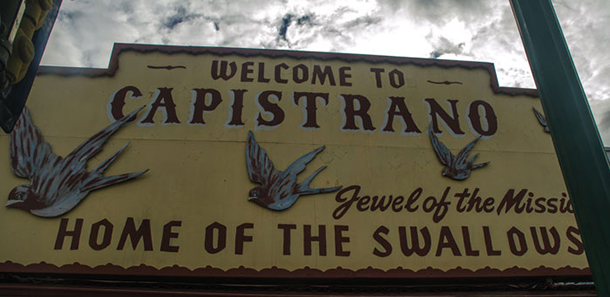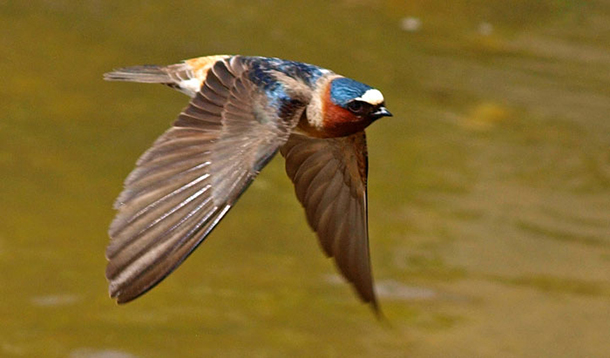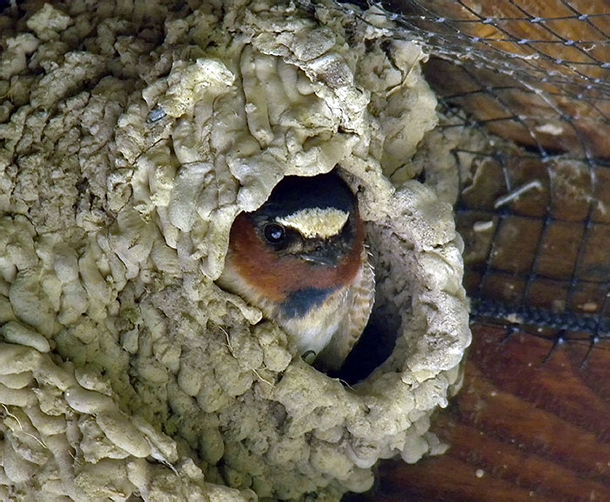BirdNote: Swallows of Capistrano
Air Date: Week of March 17, 2017

The swallows nested in the Capistrano Mission walls until the 1990s. (Photo: Wayne Hsieh)
Every spring, Cliff Swallows returned to Capistrano in Southern California, delighting locals and visitors alike. Then, as Mary McCann explains, renovation work drove them from their historic nest-sites, but now there’s hope they’ll come back.
Transcript
CURWOOD: Plenty of Americans, and not only those with Irish heritage, made sure to “wear the green” on March 17 in honor of St Patrick. But there’s another saint who celebrates his special day just two days later, and as Mary McCann explains in today’s BirdNote, he has special significance for swallows and a captivating spot in southern California.
http://birdnote.org/show/swallows-capistrano
BirdNote®
The Swallows of Capistrano
MCCANN: Every year, the change from winter to spring brings millions of Cliff Swallows northward from Argentina to North America.
[Cliff Swallow vocalizations: http://macaulaylibrary.org/audio/111063]

One swallow in flight. (Photo: Bryce Bradford)
Some swallows, those that nested in the Mission of San Juan Capistrano, about halfway between Los Angeles and San Diego, were destined for fame.
Since the early 1800s, the swallows had returned, year after year, to the same mud nests built high on the stone cathedral walls of the mission.
[Cliff Swallow vocalizations: http://macaulaylibrary.org/audio/111063]
The swallows arrived on or about March 19th, St. Joseph’s Day. So regular was the cycle that, over many years, the Catholic feast of St. Joseph’s Day and the return of the birds became intertwined and were celebrated together.
When a catchy song hit the radio airwaves in 1940, nearly everybody came to know the swallows of Capistrano.
[https://www.youtube.com/watch?v=VUSC37bLuuU]
But today, Cliff Swallows no longer nest at the mission. During a restoration project in the 1990s, the venerable mud nests were removed from the mission walls. Since then the birds have opted to reside elsewhere in town.
Now, though, a concerted effort is under way to attract the beloved swallows back to the mission, an effort that includes putting up man-made nests.
[MUSIC: “When the Swallows Come Back To Capistrano.”]
As to whether the swallows will ever really return, though, only time will tell.
I’m Mary McCann.

A swallow nests. (Photo: Mike Hamilton)
###
Written by Bob Sundstrom
Bird sounds provided by The Macaulay Library of Natural Sounds at the Cornell Lab of Ornithology, Ithaca, New York. 111063 Recorded by Thomas G. Sander.
BirdNote’s theme music was composed and played by Nancy Rumbel and John Kessler.
Producer: John Kessler
Executive Producer: Sallie Bodie
© 2017 Tune In to Nature.org March 2017 Narrator: Mary McCann
CURWOOD: And soar on over to our website LOE.org for some photos.
Links
Living on Earth wants to hear from you!
Living on Earth
62 Calef Highway, Suite 212
Lee, NH 03861
Telephone: 617-287-4121
E-mail: comments@loe.org
Newsletter [Click here]
Donate to Living on Earth!
Living on Earth is an independent media program and relies entirely on contributions from listeners and institutions supporting public service. Please donate now to preserve an independent environmental voice.
NewsletterLiving on Earth offers a weekly delivery of the show's rundown to your mailbox. Sign up for our newsletter today!
 Sailors For The Sea: Be the change you want to sea.
Sailors For The Sea: Be the change you want to sea.
 The Grantham Foundation for the Protection of the Environment: Committed to protecting and improving the health of the global environment.
The Grantham Foundation for the Protection of the Environment: Committed to protecting and improving the health of the global environment.
 Contribute to Living on Earth and receive, as our gift to you, an archival print of one of Mark Seth Lender's extraordinary wildlife photographs. Follow the link to see Mark's current collection of photographs.
Contribute to Living on Earth and receive, as our gift to you, an archival print of one of Mark Seth Lender's extraordinary wildlife photographs. Follow the link to see Mark's current collection of photographs.
 Buy a signed copy of Mark Seth Lender's book Smeagull the Seagull & support Living on Earth
Buy a signed copy of Mark Seth Lender's book Smeagull the Seagull & support Living on Earth

